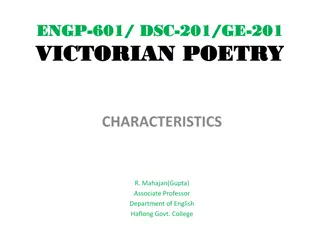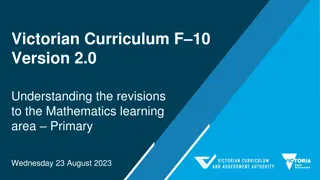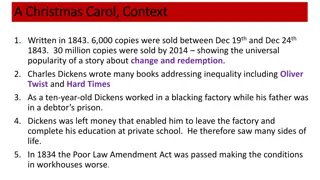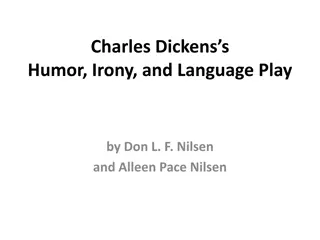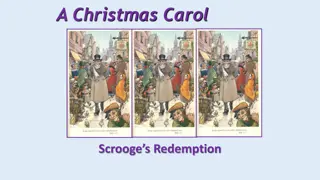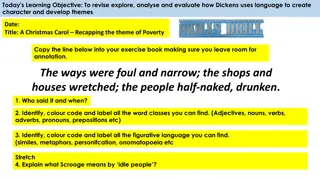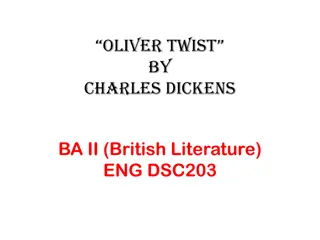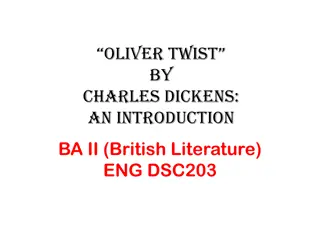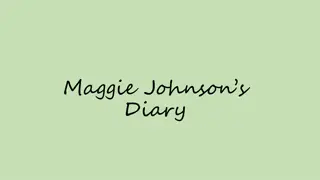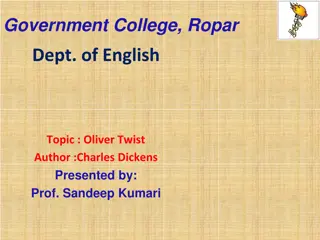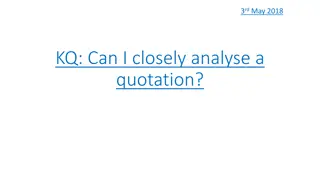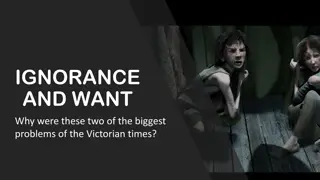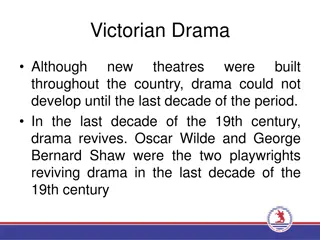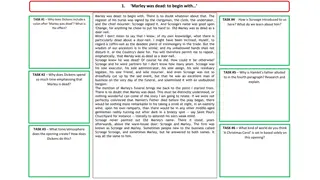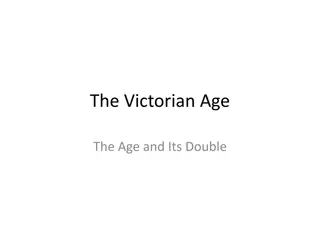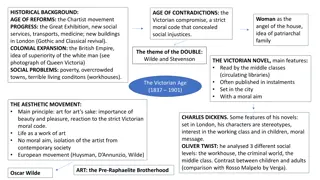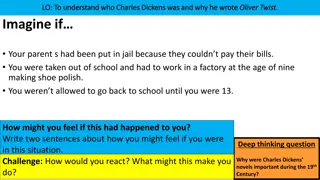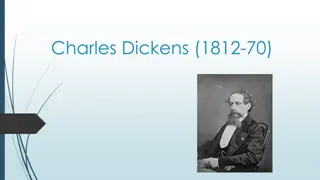Understanding the Victorian Era and Charles Dickens through "Bleak House
The Victorian age, marked by significant societal transformations and literary innovations, is epitomized in the works of acclaimed British author Charles Dickens. His novel "Bleak House" vividly portrays the struggles of the Jarndyce family amidst a complex legal battle, reflecting Dickens' critique of the Court of Chancery. Explore how Dickens' writings captured the essence of Victorian values and societal changes, making him a pivotal figure in 19th-century literature.
Download Presentation

Please find below an Image/Link to download the presentation.
The content on the website is provided AS IS for your information and personal use only. It may not be sold, licensed, or shared on other websites without obtaining consent from the author. Download presentation by click this link. If you encounter any issues during the download, it is possible that the publisher has removed the file from their server.
E N D
Presentation Transcript
BLEAK CHARLES DICKENS HOUSE
The victorian age: The Victorian period of literature roughly coincides with the years that Queen Victoria ruled Great Britain and its Empire (1837-1901). During this era, Britain was transformed from a predominantly rural, agricultural society into an urban, industrial one. New technologies like railroads and the steam printing press united Britons both physically and intellectually. Although now the period is popularly known as a time of prim, conservative moral values, the Victorians perceived their world as rapidly changing. Religious faith was splintering into evangelical and even atheist beliefs. The working class, women, and people of color were agitating for the right to vote and rule themselves. Reformers fought for safe workplaces, sanitary reforms, and universal education. Victorian literature reflects these values, debates, and cultural concerns. Victorian literature differs from that of the eighteenth century and Romantic period most significantly because it was not aimed at a specialist or elite audience; rather, because the steam printing press made the production of texts much cheaper and because railroads could distribute texts quickly and easily, the Victorian period was a time when new genres appealed to newly mass audiences
Authors biography: Charles Dickens was a British novelist, journalist, editor, illustrator and social commentator who wrote such beloved classic novels as Oliver Twist, A Christmas Carol, Nicholas Nickleby, David Copperfield, A Tale of Two Cities and Great Expectations Dickens is remembered as one of the most important and influential writers of the 19th century. Among his accomplishments, he has been lauded for providing a stark portrait of the Victorian-era underclass, helping to bring about social change.Dickens wrote some of the most famous novels of his time, including Oliver Twist, Great Expectations, A Tale of Two Cities, and A Christmas Carol.Dickens enjoyed a wider popularity during his lifetime than had any previous author. Much in his work could appeal to the simple and the sophisticated, to the poor and to the queen, and technological developments as well as the qualities of his work enabled his fame to spread worldwide very quickly. His long career saw fluctuations in the reception and sales of individual novels, but none of them was negligible or uncharacteristic or disregarded, and, though he is now admired for aspects and phases of his work that were given less weight by his contemporaries, his popularity has never ceased
related to novel: Bleak House, novel by British author Charles Dickens, published serially in 1852 53 and in book form in 1853 and considered to be among the author s best work. Bleak House is the story of the Jarndyce family, who wait in vain to inherit money from a disputed fortune in the settlement of the extremely long-running lawsuit of Jarndyce and Jarndyce. The novel is pointedly critical of England s Court of Chancery, in which cases could drag on through decades of convoluted legal maneuvering.At the centre of Bleak House is a long- running legal case in the Court of Chancery, Jarndyce and Jarndyce, which comes about because a testator has written several conflicting wills. In a preface to the 1853 first edition, Dickens claimed there were many actual precedents for his fictional case. One such was probably the Thellusson v Woodford case in which a will read in 1797was contested and not determined until 1859. Though many in the legal profession criticised Dickens's satire as exaggerated
Plot summary: in the Court of Chancery, where civil suits are decided, there is an inheritance case called Jarndyce and Jarndyce that has been going on for several generations. One guy has actually committed suicide over it. Ada Clare and Richard Carstone are orphans connected with the case. Esther Summerson is a girl raised in isolation by an angry aunt. The three are united one day by a man named John Jarndyce (Ada and Richard's distant cousin), who spends his money on random philanthropic causes all around the country.Meanwhile, the very old, rich, important, and fashionable Dedlock family has a loyal attorney named Tulkinghorn, who takes the reputation of the Dedlocks very seriously. Lady Dedlock is also marginally connected with the Jarndyce case, and one she day pays an unusual amount of attention to the handwriting on one of Tulkinghorn's legal documents. This seems minor, but it makes Tulkinghorn go crazy with suspicion, and he begins investigating.The guy whose handwriting it is calls himself Nemo. He lives in a tiny room in the house of a weird old man named Krook, who keeps a warehouse full of odds and ends that he calls a store. Just as Tulkinghorn finds him, Nemo kills himself by an overdose of opium. We don't know whether this was an accident or a suicide. At the inquest, the only person who knew Nemo is a street sweeper boy named Jo, who is as poor and sad a human as ever could be. Illiteracy, dirt, malnourishment, lack of education you name it, Jo has it. Tulkinghorn tells the Dedlocks the story of Nemo.One day a veiled but obviously wealthy woman finds Jo and makes him take her to all the places associated with Nemo where he lived and died, where he worked, and where he was buried. Jo is later found by Tulkinghorn and his detective, Bucket. When they show him another, similarly veiled woman, Jo recognizes the clothes but it's not the same woman. She turns out to be Hortense, Lady Dedlock's ex-maid, who is furious at having been fired. She becomes even more furious when Tulkinghorn doesn't find her a job.John Jarndyce has fallen in love with Esther and asked her to marry him. She consents out of respect for Jarndyce but during the engagement she falls in love with Allan Woodcourt. When Jarndyce learns of her feelings for Allan he releases her from the engagement and she marries Woodcourt. The chancery case comes to a close with court costs eating up all of the estate. Carstone, who has married Ada, dies in despair.
Main characters: Esthersummerson: The narrator and protagonist. Esther, an orphan, becomes the housekeeper at Bleak House when she, Ada, and Richard are taken in by Mr. Jarndyce. Everyone loves Esther, who is selfless and nurturing, and she becomes the confidante of several young women Mr.JohnJarndyce: Esther s guardian and master of Bleak House. Mr. Jarndyce becomes the guardian of the orphans Ada and Richard and takes Esther in as a companion for Ada. Generous but uncomfortable with others gratitude AdaClare: ward of Jarndyce. Kind, sweet, and na ve, Ada becomes Esther s closest confidante and greatest source of happiness. She falls in love with Richard RichardCarstone: A ward of Jarndyce. Affablebut lazy, Richard can t decide on a career and seems to have no passion for a particular field LadyDedlock : Mistress of Chesney Wolrld married to Sir Leicester, and Esther s mother. Lady Dedlock, revered and wealthy, has kept the secret of her illegitimate child throughout her life, believing the child died at birth SirLeicesterDedlock: Master of Chesney Wold. Sir Leicester is a strong, respected man who ultimately withers and weakens because of Lady Dedlock s disappearance Mr Tulkinghorn: A lawyer involved in the Jarndyce and Jarndyce lawsuit. Mr. Tulkinghorn shares Lady Dedlock s secret and threatens to reveal it. Mrs Baytham Badger: A woman who talks incessantly about her former husbands.
Theme: Thesearchforlove:Almost every character in Bleak House is searching for love, a search that proves to be equally rewarding and difficult. Esther quietly searches for love, even though she seems too busy taking care of others to think much about her own romantic situation Theimportanceofdangorandpassion:In Bleak House, passio both important and dangerous, sometimes healthy and satisfying, sometimes harmful and destructive. Many characters recognize the importance of passion for a fulfilling life Theambiguousdefinitionofmother:Throughout Bleak House, the role of mother is filled by women who often are not real mothers at all. Charley, a child herself, cares for her two young siblings, all of them orphaned and struggling Law vs. Justice:Many of the characters in Bleak House are involved in a notorious lawsuit known as Jarndyce and Jarndyce, which has been in dispute in the court of Chancery for several generations. Passion, Obsession, and Madness:Dickens clearly sees the value of following one s passion, as his characters who do not feel a calling in life are somewhat lost and forlorn throughout the book. Identity and Appearance:Appearances can be deceiving in Bleak House, and the identity that a person presents to the world does not necessarily represent their inner life or their real personality.
Narrative structure: Much criticism focuses on its structure: it is told both by a third- person omniscient narrator and a first-person narrator Summerson). The omniscient narrator speaks in the present tense and is a dispassionate observer. Summerson tells her own story in the past tense (like Copperfield or Expectations), and her narrative voice is characterised consciousness of her own limits, and willingness to disclose to us her own thoughts and feelings. These two narrative strands intersect, though they do run in parallel. of unique Bleak House narrative (Esther Esther David Pip in in David Great by modesty, never quite
Symbolism Theeastwind: The east wind represents any vexing event, person, or possibility that upsets or threatens to upset Mr. Jarndyce. Mr. Jarndyce, steadfast and good-natured, rarely expresses displeasure with anyone or voices his unhappiness or worry. Instead, when he is agitated, he remarks that the wind is in the east, and those who know him understand what he means MissFlite'sbirds: Miss Flite s remarkable collection of caged birds represents the unfortunate people who have been trapped after becoming involved with the Jarndyce and Jarndyce lawsuit. Miss Flite, who has followed the suit faithfully for years and has never stopped expecting a judgment, plans to release her birds when the judgment finally comes Mr.Woodcourt'sflowers: The flowers Mr. Woodcourt gives Esther before he goes to sea initially represent a secret burgeoning love but later represent a past that can never be revisited. Esther doesn t tell us very much about the flowers, only hinting at who gave them to her and what they signify. After her face has been scarred by smallpox, however, she confronts the flowers directly in her narrative
Important quotation: 1)I have a great deal of difficulty in beginning to write my portion of these pages, for I know I am not clever. Meaning: These words, which form the first sentence of chapter 3, A Progress, are the first words of Esther s narrative, the first we hear of her voice. There are two remarkable elements to this quotation. First, Esther seems to be aware that she is telling this story in tandem with someone else. She says that these pages will be my portion, suggesting that she knows that the tale is not entirely hers. Although Esther never refers to the third- person narrator with whom she shares the telling of Bleak House, she is aware of him, and she goes on to tell her story. 2) It was grand to see how the wind awoke, and bent the trees, and drove the rain before it like a cloud of smoke; and to hear the solemn thunder, and to see the lightning; and while thinking with awe of the tremendous powers by which our little lives are encompassed. Meaning: This quotation appears in chapter 18, Lady Dedlock, one week after Esther saw Lady Dedlock for the first time and felt a strange connection to her. Esther, Ada, and Mr. Jarndyce, who are visiting Mr. Boythorn in Lincolnshire, wait out a violent storm in a keeper s lodge, and Esther makes these observations as she looks out from the doorway. 3)Thus Chesney Wold. With so much of itself abandoned to darkness and vacancy; with so little change under the summer shining or the wintry lowering; so sombre and motionless always Meaning: This quotation concludes chapter 66, Down in Lincolnshire, as well as the third-person narrator s portion of the novel. In the paragraph that precedes this quotation, the narrator tells us that Chesney Wold is so desolate that people are afraid to walk in it by themselves and that a maid became so depressed that she couldn t stay there. Here, the narrator concludes his description of Chesney Wold s deathlike state.
HistoricalContextof BleakHouse Bleak House is set in the mid-1800s and addresses several issues which would have been relevant and familiar to his Victorian audience. The novel s philanthropist characters, like Mrs. Pardiggle and Mr. Quale, reflect the 19th-century vogue for social engagement in charitable causes and the fashion among middle-class people for social organization. Although Dickens is critical of these character s efforts, the 19th century was a period of rapid social reform in which ideas such as social care for the poor and infirm were seriously considered and acted upon for the first time in modern history at a governmental level. The 19th century was also a period of colonial expansion in Britain; the Victorian establishment, ruled over by Queen Victoria, who came to the throne in 1837, put a great deal of resources into establishing colonies abroad in places like India and Africa. Although this was considered a national enterprise, colonial expansion was not always popular among the general public, who felt that the tax spent on the Empire could be used more effectively at home. Dickens gives voice to this discontent through the figure of Mrs. Jellyby. Dickens also addresses social issues, such as the terrible living conditions of the industrial poor in the slums of London and the spread of disease through unsanitary burial practices and through the foul water of the Thames, which many poor people used for both bathing and drinking
Satire: For most readers and scholars, the central concern of Bleak House is its indictment of the English Chancery court system. Chancery or equity courts were one half of the English civil justice system, existing side-by- side with law courts. Chancery courts heard actions having to do with wills and estates, or with the uses of private property. By the mid-nineteenth century, English law reformers had long criticised the delays of Chancery litigation, and Dickens found the subject a tempting target. He already had taken a shot at law- courts and that side of the legal profession in his 1837 novel The Posthumous Papers of the Pickwick Club or The Pickwick Papers. Scholars, such as the English legal historian Sir William Searle Holdsworth, in his 1928 series of lectures,have made a plausible case for treating Dickens's novels, particular, as primary sources illuminating the history of English law and Bleak House in
The End Omolbanin.Saeid


